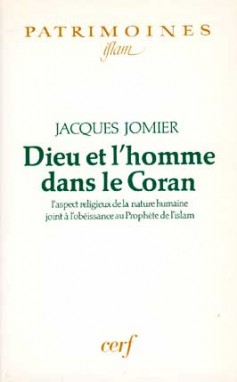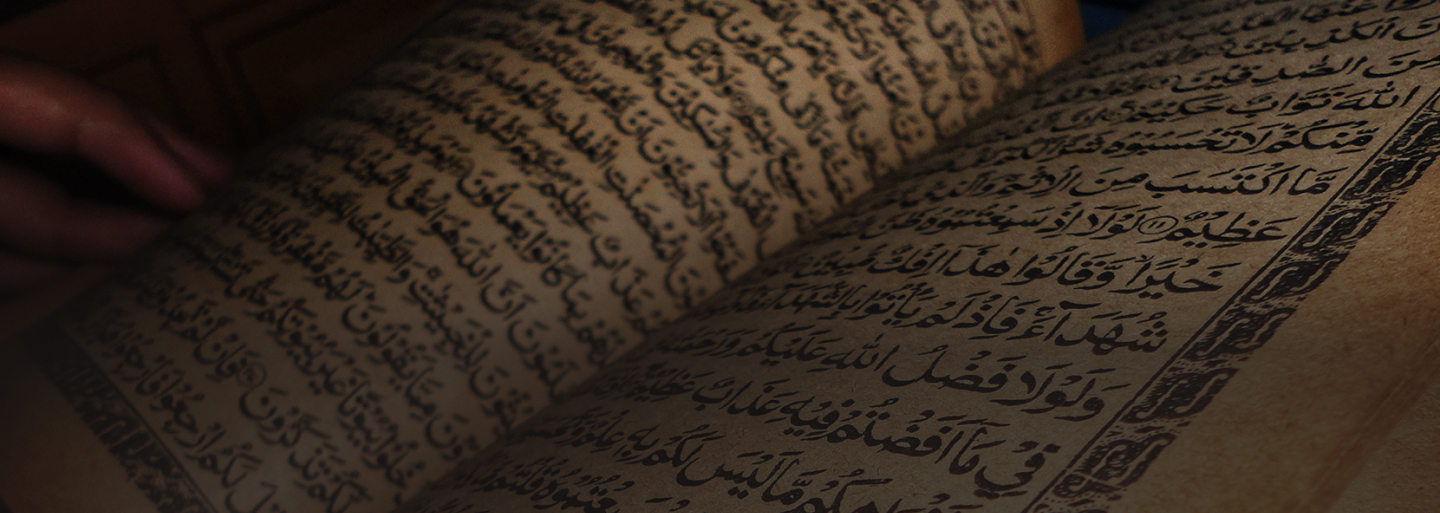Psychological Readings of the Qurʾan
By Gabriel Said Reynolds (University of Notre Dame)
In his 1996 work Dieu et l’homme dans le Coran the French Dominican scholar Jacques Jomier devotes a chapter to ”The Psychological Certainty of Muslims” (“La certitude psychologique du musulman”). The premise of this chapter is that Muslims are especially confident of the truth of their faith. Jomier explains:
In many circumstances Muslims appear sure of their faith, persuaded that it is self-evident, even suspecting (in certain extreme cases) that those who do not share their faith are insincere.[1]

From Jomier’s perspective some Muslims are so certain of their religion that they imagine even non-Muslims secretly recognize the truth of Islam (he finds this idea implicit in a verse of the Qurʾan– Q 2:42 – which tells the Jews not to conceal the truth that they know). Jomier presumably developed his notion regarding “the psychological certainty” of Muslims from his many years living in Egypt (1945-1981). He does not, however, seek to prove this notion in any systematic way.
Are Muslims in fact especially “certain” of their religion? Pew has found (in a 2011 survey) that only 35% of American Muslims answered yes to the proposition “Your religion is the one true faith” (compared to 30% of American Christians).[2] It may be that a higher percentage of Muslims from Islamic countries such as Egypt would answer yes to this question. Pew did not ask the same question when it surveyed Egyptian Muslims in 2012. In that survey, however, Pew did find that 78% of Egyptian Muslims report that “there is only one true way” to interpret the teachings of Islam, a result which may correspond, indirectly, with Jomier’s notion of certainty.[3]
In any case, my point here is not to prove or disprove Jomier’s notion of the “psychological certainty of Muslims.” Instead I’d like to draw attention to his explanation for this supposed phenomenon. According to Jomier there is something in the nature of the Qurʾan itself which engenders certainty. Jomier points to the simplicity and binarity of the Qurʾanic style. The Qurʾan, he argues, leaves the audience with only two stark choices: submission to God or rebellion against Him. Commenting on Qurʾan 6:50 (where the Prophet is commanded to say, “Can the blind and the seeing be deemed equal? Will you not, then, take thought?”), Jomier observes, “All of one’s attention is drawn to the question regarding which no doubt is possible.”[4] Elsewhere he describes the “binary” style of the Qurʾan in more general terms: “There is God or there is not God, there is the blind and the seeing, truth and falsehood, the believer and the unbeliever, the good to do and the evil to avoid, paradise and hell.”[5]
Jomier’s efforts to describe how the rhetorical turns of the Qurʾan engender psychological certainty are taken up in a second French language work: L’action psychologique dans le Coran, “Psychological Action [or Operation] in the Qurʾan” by Dominique and Marie-Therèse Urvoy.[6] The Urvoys develop the ideas of Jomier still further, attempting to identify certain “strategies” of the Qurʾan’s rhetoric, strategies intentionally deployed to win the unyielding allegiance of its audience. Under the rubric of “Subliminal Processes” in the Qurʾan the Urvoys include something they name the “subtle insertion” (literally, “sliding in,” Fr. “glissement”) of secondary messages. They argue that the Qurʾan has a way of adding in “almost insidiously” a secondary message, parallel to the development of a principal theme, in a manner which is “practically subliminal.”[7] The ideas of the Urvoys far exceed a simply analysis of the Qurʾan’s logical strategies of argumentation, such as that found in Rosalind Ward Gwynne’s Logic, Rhetoric, and Legal Reasoning in the Qurʾan.[8] Indeed the Urvoys seem to go further still than Jomier in insisting that the Qurʾan’s author intentionally (“almost insidiously”) imbedded certain patterns in the text in order to win total devotion from his audience.
The studies of Jomier and the Urvoys on these matters are fundamentally problematic. They assign a contrived motive to the Qurʾanic author which exceeds simple argumentation. In addition they underestimate the intellectual independence of the Qurʾan’s audience.
Still it is worth noting that their arguments – strangely enough – have certain connections to Islamic apologetical works which are meant to underline the supposed brilliance of Qurʾanic rhetoric. Notably Jomier was particularly interested in the arguments of Muhammad Ahmad Khalafallah (d. 1991), the author of the well-known 1951 work al-Fann al-qasasi fi al-Qurʾan al-karim, “Narrative Art in the Noble Qurʾan.” Jomier was one of the first scholars to draw attention to this work – and to the controversy which it engendered — in a long 1954 article entitled “Quelques positions actuelles de l’exégèse coranique en Egypte révélées par une polémique récente.”[9] As Jomier notes, the original form of Khalafallah’s work – that is, his dissertation at King Fuʾad University (now the University of Cairo) – was entitled Min asrar al-iʿjaz, “On the Secrets of [the Qurʾan’s] Inimitability.” Khalafallah originally wrote this study of Qurʾanic “inimitability” to combat the views of “atheists, Orientalists, and missionaries.”[10]
In order to wage this combat Khalafallah sought to show that the Qurʾan need not be judged by the historical accuracy of the stories which it tells, since those stories were written not with the goal of relating “historical truth” but rather “literary truth” (al-ḥaqīqa al-adabiyya).[11] In other words, from his perspective the Qurʾan relates stories in a way meant to convince its audience of its message, and in a special way to inspire fear and piety among them. At one point Khalafallah comments that the Qurʾan’s stories appeal to the “emotional logic” (manṭiq al-ʿaṭifa) of its audience, and not to the “logic of intellectual reflection” (manṭiq al-naẓar al-ʿaqli).[12] This does not take us very far from the Urvoys’ notion of the Qurʾan’s psychological “action.”
A more recent pious exploration of the Qurʾan’s supposed ability to convince or enrapture its audience is found in Navid Kermani’s God is Beautiful.[13] Kermani, who focuses on the reception history of the Qurʾān, describes in vivid detail Islamic stories meant to redound to the doctrine of Qurʾanic inimitability. He is particularly interested in those traditions which speak of pious believers who were so affected by hearing the Qurʾan that they were struck down and died.[14] Now Kermani does not imagine that his readers will all accept the idea of Qurʾanic inimitability. As he puts it, Kermani does not expect every reader to “sway to the rhythm of the Qurʾān recitations.”[15] He does, however, seem convinced that there is something remarkable in Qurʾanic rhetoric, and in its sound, which leads its audience to be swept away. At the same time Kermani does recognize that there are certain historical and sectarian factors which led to the development of the Islamic doctrine of the Qurʾan’s inimitability.[16]
Still it seems to me that the critical works of Jomier and the Urvoys, and the more apologetical works of Khalafallah and Kermani are two sides of the same coin. The notion that there is something contrived, magical, or miraculous in Qurʾanic rhetoric that overwhelms its audience is simplistic. Of course there are many pious Muslims (and non-Muslims) who are enthralled with the rhetoric of the Qurʾan. Some converts attribute their conversions to the qualities of the Qurʾan (ʿUmar, the second caliph, is said to have accepted Islam after hearing a recitation of the Qurʾan). But others are not. One of the Prophet’s own scribes, Ibn Abi Sarh, is said to have left the Prophet’s service, and Islam, when he came to believe that his messages did not come from God. Christians and other non-Muslims are compelled in the Islamic world to hear the Qurʾan time and again over loudspeakers and yet still do not convert to Islam.
In other words, religious convictions cannot be attributed simply to the logic, rhetoric, or aesthetics of a scripture. Instead such convictions are connected to a social context. Religious “certainty” is necessarily linked to the experience of belonging which believers find in a community of faith. “Certainty” is accordingly found not only with Muslims but presumably found also with others – such as evangelical Christians or Latter Day Saints – from groups in which esprit de corps (or ʿasabiyya) is strong. It is also connected to the efforts of missionaries (or “daʿwa practitioners”) whose vocation is to increase devotion among believers while bringing unbelievers into the fold. In other words, the Qurʾan, like other scriptures, does not find its meaning in a vacuum. The Qurʾan has meaning in context.
[1] J. Jomier, Dieu et l’homme dans le Coran (Paris : Cerf, 1996), 161.
[2] http://www.people-press.org/2011/08/30/muslim-americans-no-signs-of-growth-in-alienation-or-support-for-extremism/
[3] http://www.pewforum.org/2012/08/09/the-worlds-muslims-unity-and-diversity-executive-summary/
[4] Jomier, 170.
[5] Jomier, 168.
[6] Paris : Cerf, 2007.
[7] Urvoy and Urvoy, 71.
[8] London: Routledge, 2004.
[9] MIDEO 1 (1954), (39-72), 66.
[10] J. Jomier, “Quelques positions actuelles de l’exégèse coranique en Egypte révélées par une polémique récente (1947-51),” MIDEO 1 (1954), (39-72), 66 . See M.A. Khalafallah, Al-Fann al-qasasi fi al-Qurʾan al-karim, 4th edition (First edition 1951) (London: Al-Intishar al-ʿArabi, 1999), 10.
[11] The term “literary truth,” however, would disappear from the printed version of Khalafallah’s work. See Jomier, 63.
[12] Al-Fann, 155.
[13] N. Kermani, God is Beautiful, trans. T. Crawford (Maldin, MA: Polity, 2015). Original German: Gott ist schön (Munich: Beck, 1999).
[14] In particular he focuses on the work of al-Thaʿlabi (d. 427/1035): Qatlā al-qurʾān, ed. Nāṣir b. Muḥammad al-Manīʿ (Riyadh : Maktabat al-ʿUbaykān, 2008).
[15] Kermani, 251.
[16] See Kermani, 196.
………………………………………………………………………………………………………………………………………..
© International Qur’anic Studies Association, 2017. All rights reserved.
